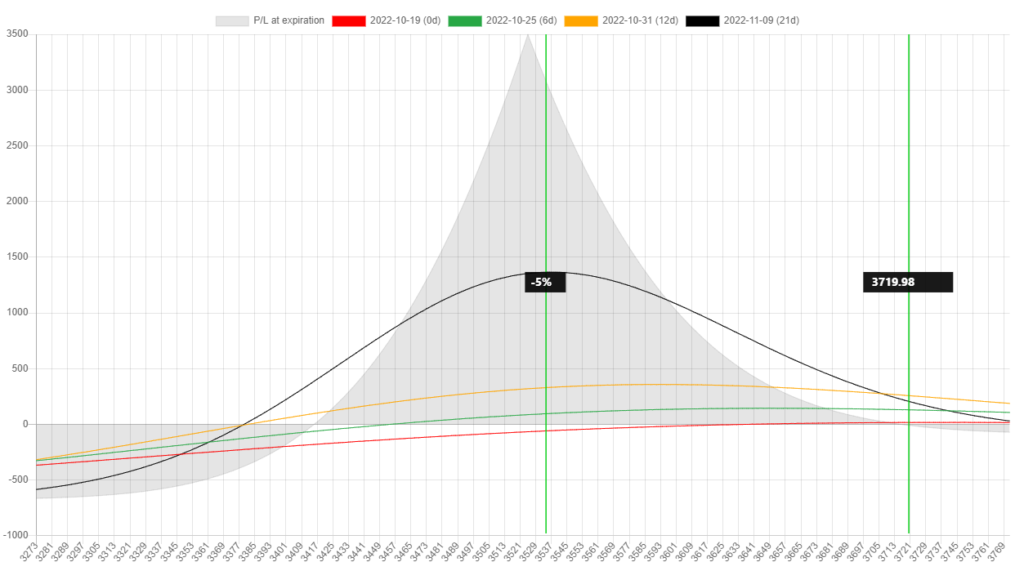I all the time needed to have a mechanism that scans the marketplace for particular SPX diagonals and alerts me at any time when discover it. That’s the reason I’ve developed an alert algorithm within the scanner in order that I would not have to manually scan for attention-grabbing setups all day, however it’ll alert me.
Let’s see what kind of diagonals I like for SPX.
-
Ticker: “SPX” as a result of I’m in search of SPX diagonals;).
-
Possibility: “put” means I’m trying just for put diagonal spreads.
-
Price: “0 – 500” means I’m solely involved in spreads which have a debit between 0 and 500 {dollars}. I’m solely in search of debit diagonals as a result of credit score ones would have totally different directional bets.
-
DTE: “0 – 30”, I’m in search of those with max 30 days to expiration.
-
Entrance delta: “20 – 45” defines the delta distance for the entrance leg of the unfold. This makes it near the cash, however not ATM the place the web delta can be constructive and I’m in search of unfavourable delta.
-
Delta: “-100 – 0” is the web delta of the place. On this scan, I’m solely in search of a unfavourable internet delta configuration as a result of then if the market begins to fall, I’m instantly making a living on the unfold. This diagonal is accumulating internet unfavourable delta as days go by by way of the impact of appeal Greek.
-
Expiration diff: “3”, means I’m in search of diagonals the place there are 3 days in between the expiration dates. That is usually Friday/Monday expiration. It’s also possible to seek for varied expiration variations.
-
Skew: “-100 – 0”, that is essentially the most essential a part of this setup, the horizontal IV skew. This setting states that I’m in search of unfavourable skew, which implies the entrance leg has the next IV than the again leg.
-
Strike diff: “5” is the interval between the lengthy and quick strikes of the diagonal. If I wish to have the scanner search for all of the variations, I might set it to 0. However for this setup, 5 is one of the best strike distinction.
-
Sort: “bull”, there are two sorts of diagonals for places and calls. Bull diagonals and bear diagonals. On this setup it is a bull put diagonal which signifies that the lengthy put has the next strike than the quick put, therefore it’s extra of a spread buying and selling setup.
-
R/R: “500 – 1000” means I’m in search of diagonals which have a reward-to-risk ratio of no less than 500%. The R/R relies on the max potential loss vs. the max potential revenue of the diagonal.
-
C/W: “10 – 100”, stands for the proportion of credit score/width I get for shorting the embedded vertical that’s discovered within the diagonal unfold. Each diagonal has an embedded vertical unfold and with this setting, I’m ensuring that it’s value promoting that embedded vertical. So if I’m in search of a min. of 10% C/W which means once I quick the vertical I get no less than 10% of the width of the vertical in credit score.
-
Vary: “0 – 100” defines how vast the breakeven vary in proportion needs to be in a calendar unfold. I left it on default.
-
Min. quantity: “1” is in search of legs which have no less than a quantity of 1 on the present day. With this, you may filter out those who have very low quantity, therefore wider bid/ask spreads.
As you may see within the picture above, I’ve solely discovered one SPX put diagonal which had 600% R/R potential and a reasonably flat configuration. Let’s undergo what the columns imply.
-
Watch: with these icons you may add a ramification to your watchlist, analyze the chance graph or copy the commerce to thinkorswim format.
-
Ticker: nothing to elucidate right here:)
-
Exp: the back and front month expiration of the diagonal unfold.
-
Diff: the day distinction between the legs’ expiration dates.
-
DTE: what number of days are till expiration within the entrance / again leg.
-
Int: the strike distinction between the legs.
-
Strike: the discovered strikes of the diagonal unfold.
-
Decide: choice is both name or put.
-
Tg%: goal %, how far the strike is in proportion transfer from the present inventory value.
-
TgΔ: the goal delta of the unfold which is the entrance delta on this case.
-
Price: debit of the unfold.
-
Revenue: the theoretical max. revenue you may make on the precise calendar unfold.
-
Threat: the chance of the commerce, on this case, the debit paid.
-
R/R: reward to danger in proportion.
-
C/W: proportion credit score/width of the embedded vertical.
-
Skew: the horizontal IV skew of the legs. Adverse means it’s backwardated that’s the entrance leg has the next IV than the again month.
-
Vary: what’s the value vary in proportion between the breakeven factors of the unfold (how vast is).
-
Delta: internet delta of the unfold.
-
Gamma: internet gamma of the unfold. Theta: internet theta of the unfold.
-
Vega: internet Vega of the unfold.
Threat graph of the place
Right here is the chance graph of that one diagonal above.

You may inform from the chance graph that this configuration is fairly vast and flat by way of internet delta. It makes cash with time and route. Since I like these diagonals, I’ve created a scan template for it and clicking on the alert button, I’ll get notified at any time when this setup comes round through the day. That is fairly uncommon, so I won’t get an alert day-after-day, however in a excessive IV setting, it’s extra widespread.
Diagonal scanner information
For a extra detailed rationalization of learn how to use the diagonal unfold scanner please watch the next video.
Particular SO provide:
If you happen to join NinjaSpread till 11.30.2022, you get 30 day free trial as an alternative of 14 day and 20% low cost. Coupon code: SO10

